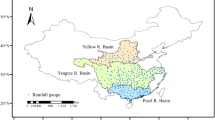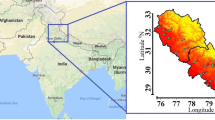Abstract
The community of climate change impact assessments and adaptations research needs regional high-resolution (spatial) meteorological data. This study produced two downscaled precipitation datasets with spatial resolutions of as high as 3 km by 3 km for the Heihe River Basin (HRB) from 2011 to 2014 using the Weather Research and Forecast (WRF) model nested with Final Analysis (FNL) from the National Center for Environmental Prediction (NCEP) and ERA-Interim from the European Centre for Medium-Range Weather Forecasts (ECMWF) (hereafter referred to as FNLexp and ERAexp, respectively). Both of the downscaling simulations generally reproduced the observed spatial patterns of precipitation. However, users should keep in mind that the two downscaled datasets are not exactly the same in terms of observations. In comparison to the remote sensing-based estimation, the FNLexp produced a bias of heavy precipitation centers. In comparison to the ground gauge-based measurements, for the warm season (May to September), the ERAexp produced more precipitation (root-mean-square error (RMSE) = 295.4 mm, across the 43 sites) and more heavy rainfall days, while the FNLexp produced less precipitation (RMSE = 115.6 mm) and less heavy rainfall days. Both the ERAexp and FNLexp produced considerably more precipitation for the cold season (October to April) with RMSE values of 119.5 and 32.2 mm, respectively, and more heavy precipitation days. Along with simulating a higher number of heavy precipitation days, both the FNLexp and ERAexp also simulated stronger extreme precipitation. Sensitivity experiments show that the bias of these simulations is much more sensitive to micro-physical parameterizations than to the spatial resolution of topography data. For the HRB, application of the WSM3 scheme may improve the performance of the WRF model.









Similar content being viewed by others
References
Caldwell P, Chin HNS, Bader DC, Bala G (2009) Evaluation of a WRF dynamical downscaling simulation over California. Clim Chang 95:499–521
Cheng G, Li X, Zhao W, Xu Z, Feng Q, Xiao S, Xiao H (2014) Integrated study of the water–ecosystem–economy in the Heihe River basin. National Science Review 1:413–428
Chubb T, Manton MJ, Siems ST, Peace AD, Bilish SP (2015) Estimation of wind-induced losses from a precipitation gauge network in the Australian Snowy Mountains. J Hydrometeorol 16:2619–2638
Collins WD, Rasch PJ, Boville BA, Hack JJ, McCaa JR, Williamson DL, Kiehl JT, Briegleb B, Bitz C, Lin S-J, Zhang MH, Dai YJ. 2004. Description of the NCAR Community Atmosphere Model (CAM3.0). NCAR Tech. Note NCAR/TN-464 + STR, 214 pp., Natl. Cent. for Atmos. Res., Boulder, Colo
Dee DP, Co-others (2011) The ERA-Interim reanalysis: configuration and performance of the data assimilation system. Q J Roy Meteor Soc 137:553–597. doi:10.1002/qj.828
Ekström M, Grose MR, Whetton PH (2015) An appraisal of downscaling methods used in climate change research. Wiley Interdiscip Rev Clim Chang 6:301–319
Gao Y, Chen F, Barlage M, Liu W, Cheng G, Li X, Yu Y, Ran Y, Li H, Peng H, Ma M (2008) Enhancement of land surface information and its impact on atmospheric modeling in the Heihe River basin, northwest China. J Geophys Res 113:D20S90. doi:10.1029/2008JD010359
García-Díez M, Fernández J, San-Martín D, Herrera S, Gutiérrez JM (2015) Assessing and improving the local added value of WRF for wind downscaling. J Appl Meteorol Clim 54:1556–1568
Giorgi F, Gutowski WJ Jr (2015) Regional dynamical downscaling and the CORDEX initiative. Annu Rev Environ Resour 40:467
Grell GA, Freitas SR (2013) A scale and aerosol aware stochastic convective parameterization for weather and air quality modeling. Atmos Chem Phys Discuss 13:23845–23893
Han S, Yang Z (2013) Cooling effect of agricultural irrigation over Xinjiang, northwest China from 1959 to 2006. Environ Res Lett 8:024039
Harris RMB, Grose MR, Lee G, Bindoff NL, Porfirio LL, Fox-Hughes P (2014) Climate projections for ecologists. Wiley Interdiscip Rev Clim Chang 5:621–637
Heikkilä U, Sandvik A, Sorteberg A (2011) Dynamical downscaling of ERA-40 in complex terrain using the WRF regional climate model. Clim. Dynam. 37:1551–1564
Hong S-Y, Lim J-OJ (2006) The WRF single-moment 6-class microphysics scheme (WSM6). J Korean Meteor Soc 42:129–151
Hong S-Y, Pan H-L (1996) Nonlocal boundary layer vertical diffusion in a medium-range forecast model. Mon Weather Rev 124:2322–2339
Hong S-Y, Dudhia J, Chen S-H (2004) A revised approach to ice microphysical processes for the bulk parameterization of clouds and precipitation. Mon Weather Rev 132:103–120
Hu Y, Zhang X-Z, Mao R, Gong D-Y, Liu H-B, Yang J (2015) Modeled responses of summer climate to realistic land use/cover changes from the 1980s to the 2000s over eastern China. J Geophys Res 120:167–179. doi:10.1002/2014JD022288
Kessler E. 1969. On the distribution and continuity of water substance in atmospheric circulation. Meteorological Monographs, 10: Am. Meteor. Soc., Boston, MA, 84 pp
Lin YL, Farley RD, Orville HD (1983) Bulk parameterization of the snow field in a cloud model. J Clim Appl Meteorol 22:1065–1092
Liu JY, Kuang WH, Zhang ZX (2014) Spatiotemporal characteristics, patterns, and causes of land-use changes in China since the late 1980s. J Geogr Sci 24:195–210
Maraun D, Wetterhall F, Ireson AM, Chandler RE, Kendon EJ, Widmann M, Brienen S, Rust HW, Sauter T, Themessl M (2010) Precipitation downscaling under climate change: recent developments to bridge the gap between dynamical models and the end user. Rev Geophys 48:RG3003. doi:10.1029/2009RG000314
Niu G-Y, Yang Z-L, Mitchell KE, Chen F, Ek MB, Barlage M, Kumar A, Manning K, Niyogi D, Rosero E, Tewari M, Xia Y (2011) The community Noah land surface model with multiparameterization options (Noah-MP): 1. Model description and evaluation with local-scale measurements. J Geophys Res 116. doi:10.1029/2010JD015139
Pan X, Li X, Yang K, He J, Zhang Y, Han X (2014) Comparison of downscaled precipitation data over a mountainous watershed: a case study in the Heihe River basin. J Hydrometeorol 15:1560–1574
Rockel B (2015) The regional downscaling approach: a brief history and recent advances. Current Climate Change Reports 1:22–29
Skamarock WC, Klemo JB, Dudhia J, Gill DO, Barker DM, Wang W, Powers JG. 2008. A description of the Advanced Research WRF version 3. Technical Note, NCAR/TN-475 + STR, 125
Soares PM, Cardoso RM, Miranda PM, de Medeiros J, Belo-Pereira M, Espirito-Santo F (2012) WRF high resolution dynamical downscaling of ERA-Interim for Portugal. Clim. Dynam. 39:2497–2522
Teutschbein C, Seibert J (2012) Bias correction of regional climate model simulations for hydrological climate-change impact studies: review and evaluation of different methods. J Hydrol 456:12–29
Wen X, Lu S, Jin J (2012) Integrating remote sensing data with WRF for improved simulations of oasis effects on local weather processes over an arid region in northwestern China. J Hydrometeor 13:573–587
Wilby RL, Dawson CW (2013) The statistical downscaling model: insights from one decade of application. Int J Climatol 33:1707–1719
Yu E, Sun J, Chen H, Xiang W (2015) Evaluation of a high-resolution historical simulation over China: climatology and extremes. Clim Dynam 45:2013–2031
Yuan X, Liang XZ (2011) Improving cold season precipitation prediction by the nested CWRF-CFS system. Geophys Res Lett 38:L02706. doi:10.1029/2010GL046104
Zhang X, Tang Q, Pan M, Tang Y (2014) A long-term land surface hydrologic fluxes and states dataset for China. J Hydrometeorol 15:2067–2084. doi:10.1175/JHM-D-13-0170.1
Acknowledgements
This research is supported by the National Natural Science Foundation of China (Grant Nos. 91425304 and 41471171), the Youth Innovation Promotion Association CAS (2015038), and the Kezhen Outstanding Young Scholars from IGSNRR (No. 2015RC101).
Author information
Authors and Affiliations
Corresponding author
Rights and permissions
About this article
Cite this article
Zhang, X., Xiong, Z., Zheng, J. et al. High-resolution precipitation data derived from dynamical downscaling using the WRF model for the Heihe River Basin, northwest China. Theor Appl Climatol 131, 1249–1259 (2018). https://doi.org/10.1007/s00704-017-2052-6
Received:
Accepted:
Published:
Issue Date:
DOI: https://doi.org/10.1007/s00704-017-2052-6




